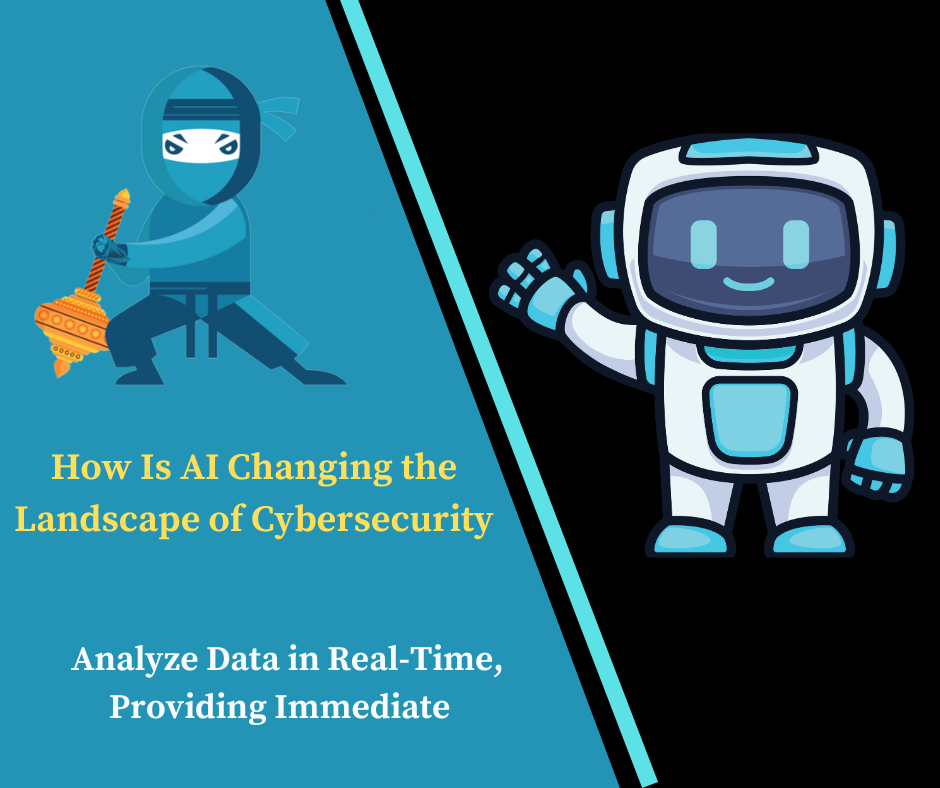How Is AI Changing the Landscape of Cybersecurity:
Artificial Intelligence (AI) is revolutionizing various sectors, and cybersecurity is no exception. The landscape of cybersecurity has evolved significantly with the integration of AI technologies, providing new ways to detect, prevent, and respond to cyber threats. This article explores how AI is reshaping the landscape of cybersecurity, highlighting its benefits, challenges, and future implications.
AI’s influence on the landscape of cybersecurity is profound, as it introduces innovative approaches to managing and mitigating cyber threats. Traditionally, cybersecurity relied heavily on static rules and manual monitoring to detect and respond to threats. However, AI brings a dynamic and adaptive layer to security, offering capabilities that can outpace traditional methods.
AI in Threat Detection and Prevention:
One of the most significant contributions of AI to the landscape of cybersecurity is its ability to enhance threat detection and prevention. Traditional security systems often rely on predefined rules and signatures to identify threats. However, with the increasing complexity and sophistication of cyber attacks, these systems are becoming less effective. AI, with its ability to learn and adapt, offers a more robust solution.
Machine Learning and Pattern Recognition:
AI-powered systems utilize machine learning algorithms to analyze vast amounts of data and identify patterns that may indicate malicious activities. These systems can detect anomalies and potential threats in real time, significantly reducing the response time to cyber incidents. For instance, AI can identify unusual network traffic patterns, flagging them for further investigation before they escalate into full-blown attacks.
Also read: How do you Measure Email Marketing ROI effectively
Behavioral Analysis:
Another way AI is transforming the landscape of cybersecurity is through behavioral analysis. By continuously monitoring user behavior, AI can establish a baseline of normal activities and detect deviations that may indicate a security breach. This proactive approach allows organizations to mitigate threats before they cause significant damage.
AI in Incident Response:
In addition to threat detection and prevention, AI is also revolutionizing incident response. When a cyber-attack occurs, a timely and effective response is crucial to minimize damage. AI-powered systems can automate many aspects of incident response, ensuring faster and more efficient mitigation of threats.
Automated Threat Hunting:
AI can assist in automated threat hunting, where it continuously searches for signs of compromise within an organization’s network. This allows security teams to focus on more complex tasks, improving overall efficiency and effectiveness.
Incident Analysis and Remediation:
AI can also aid in incident analysis by quickly correlating data from various sources to determine the root cause of an attack. This accelerates the remediation process, allowing organizations to patch vulnerabilities and strengthen their defenses against future attacks.
Challenges and Considerations:
While AI offers numerous benefits to the landscape of cybersecurity, it also presents certain challenges and considerations. Understanding these challenges is essential for organizations looking to leverage AI in their security strategies.
False Positives and Negatives:
AI systems are not infallible and may produce false positives or negatives. False positives can lead to unnecessary alerts and resource allocation, while false negatives can result in missed threats. Continuous refinement and training of AI models are necessary to minimize these issues.
Adversarial AI:
Cybercriminals are also leveraging AI to enhance their attack strategies. Adversarial AI involves using AI techniques to deceive and bypass security systems. Organizations must stay vigilant and continuously update their AI models to counteract these evolving threats.
Privacy Concerns:
The use of AI in cybersecurity often involves analyzing large volumes of data, raising privacy concerns. Organizations must ensure that they comply with relevant regulations and implement measures to protect sensitive information.
The Future of AI in Cybersecurity:
The landscape of cybersecurity will continue to evolve as AI technologies advance. Future developments may include more sophisticated AI models capable of autonomously managing security operations, reducing the need for human intervention. Additionally, AI-powered collaborative defense mechanisms, where organizations share threat intelligence in real-time, could become more prevalent, enhancing collective security.
What is AI?

Artificial Intelligence (AI) refers to the simulation of human intelligence in machines programmed to think, learn, and make decisions like humans. AI encompasses a broad range of technologies and techniques to enable machines to perform tasks that typically require human intelligence. These tasks include understanding natural language, recognizing patterns, solving problems, and making decisions.
Key Components of AI:
1. Machine Learning (ML): A subset of AI that involves training algorithms to recognize patterns and make predictions based on data. Machine learning models improve their performance over time as they are exposed to more data.
2. Deep Learning: A specialized form of machine learning that uses neural networks with many layers (hence “deep”) to model complex patterns in data. Deep learning is particularly effective in tasks like image and speech recognition.
3. Natural Language Processing (NLP): A field of AI focused on enabling machines to understand, interpret, and respond to human language. NLP is used in chatbots, language translation, and sentiment analysis applications.
4. Computer Vision: This area of AI enables machines to interpret and make decisions based on visual input, such as images or videos. It is used in applications like facial recognition and autonomous vehicles.
5. Robotic Process Automation (RPA): AI technologies are used to automate repetitive and routine tasks in business processes, improving efficiency and accuracy.
Applications of AI:
Healthcare: AI is used for diagnosing diseases, personalizing treatment plans, and analyzing medical images.
Finance: AI algorithms help in fraud detection, risk assessment, and algorithmic trading.
Retail: AI enhances customer experiences through personalized recommendations and inventory management.
Transportation: AI powers autonomous vehicles and optimizes logistics and route planning.
Customer Service: AI-driven chatbots and virtual assistants provide support and handle inquiries.
AI systems can be categorized into two types:
Narrow AI (Weak AI): AI designed to perform a specific task or set of tasks. Most AI applications today fall into this category, such as virtual assistants like Siri or Alexa.
General AI (Strong AI): AI with the ability to understand, learn, and apply intelligence across a broad range of tasks, similar to human cognitive abilities. General AI is still largely theoretical and not yet realized.
FAQ:
Q: What is the role of AI in cybersecurity?
A: AI plays a crucial role in cybersecurity by enhancing threat detection, prevention, and incident response through machine learning, pattern recognition, and behavioral analysis.
Q: How does AI improve threat detection?
A: AI improves threat detection by analyzing vast amounts of data to identify patterns and anomalies that may indicate malicious activities, allowing for real-time detection and response.
Q: What are the benefits of using AI for incident response?
A: AI aids in incident response by automating threat hunting, quickly analyzing incidents, determining root causes, and facilitating faster remediation processes.
Q: What are the challenges of using AI in cybersecurity?
A: Challenges include false positives and negatives, adversarial AI used by cybercriminals, and privacy concerns related to data analysis.
Q: How is AI expected to shape the future of cybersecurity?
A: AI is expected to lead to more autonomous security operations, enhanced collaborative defense mechanisms, and continuous advancements in threat detection and prevention capabilities.
Conclusion:
The integration of AI into the landscape of cybersecurity marks a significant shift in how organizations address cyber threats. By leveraging machine learning, behavioral analytics, and automated response mechanisms, AI enhances threat detection, prevention, and response capabilities. However, this transformation also brings challenges, including managing false positives, countering adversarial AI, and ensuring privacy and compliance. As AI technology continues to evolve, its role in cybersecurity will likely expand, offering even more sophisticated solutions to protect against an ever-changing threat landscape. Embracing AI’s potential while addressing its challenges will be key to securing the future of cybersecurity.








